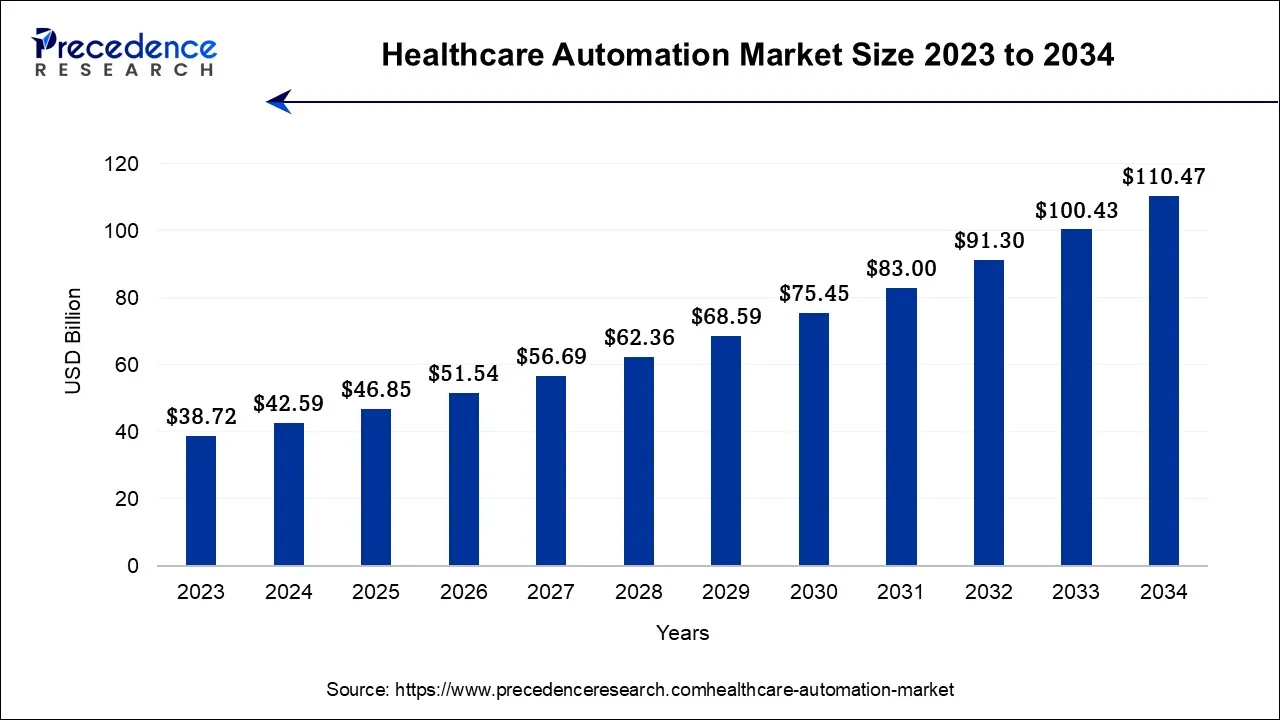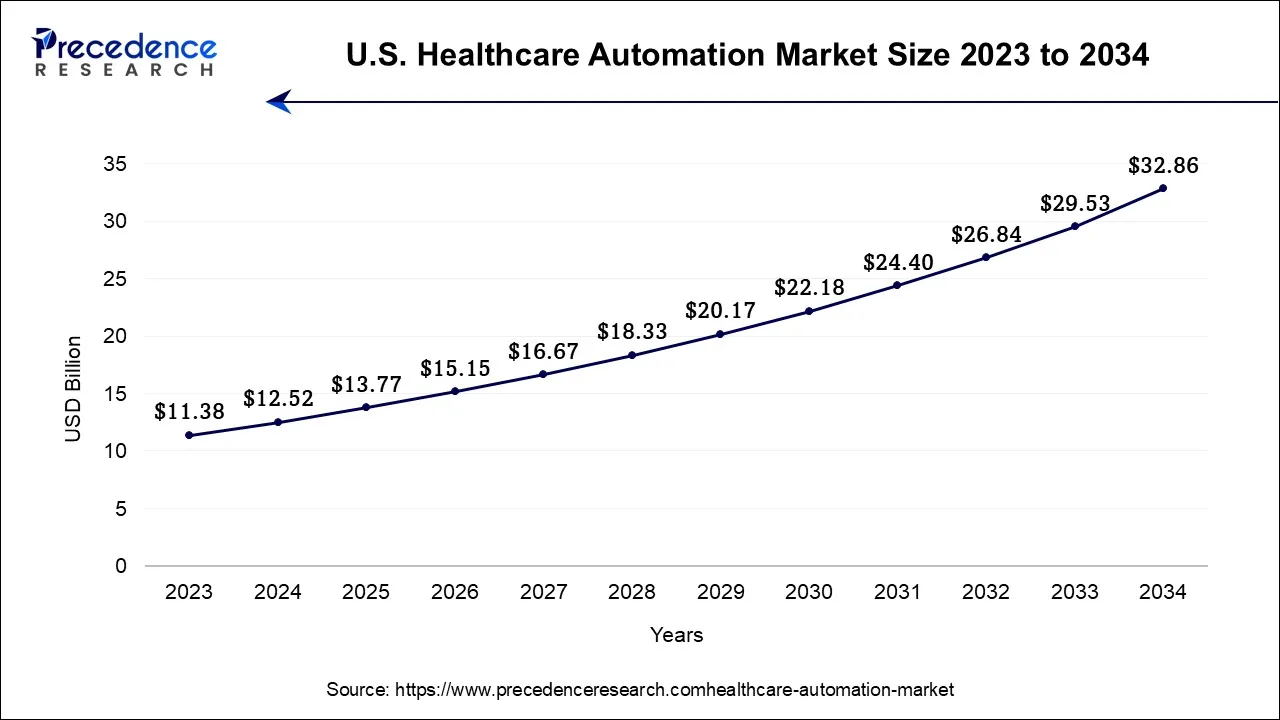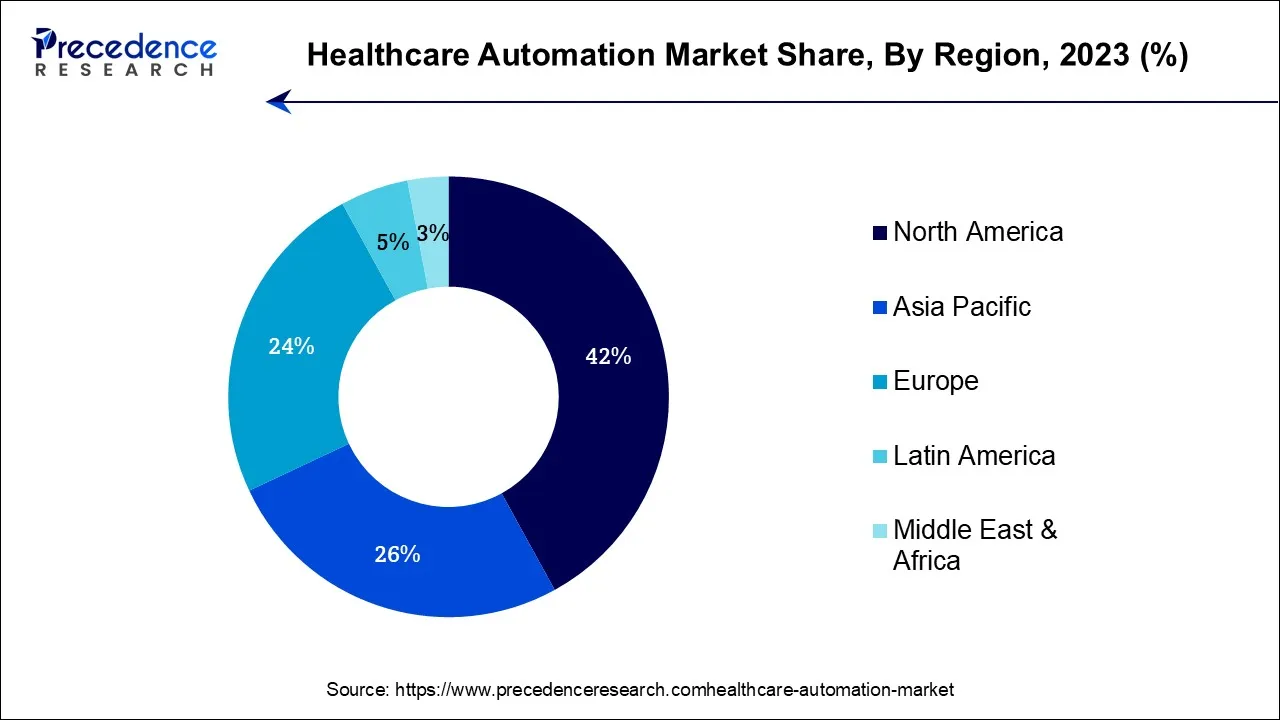January 2025
The global healthcare automation market size is calculated at USD 42.59 billion in 2024, grew to USD 46.85 billion in 2025, and is predicted to hit around USD 110.47 billion by 2034, poised to grow at a CAGR of 6.2% between 2024 and 2034. The North America healthcare automation market size accounted for USD 17.89 billion in 2024 and is anticipated to grow at the fastest CAGR of 6.33% during the forecast year.
The global healthcare automation market size is expected to be valued at USD 42.59 billion in 2024 and is anticipated to reach around USD 110.47 billion by 2034, expanding at a CAGR of 6.2% over the forecast period from 2024 to 2034. The rising telemedicine services, cost reduction, personalized treatment, and data management contribute to increasing demand for the healthcare automation market.

The U.S. healthcare automation market size accounted for USD 12.52 billion in 2024 and is projected to be worth around USD 32.86 billion by 2034, poised to grow at a CAGR of 6.35% from 2024 to 2034.

In the year 2023, North America is the dominating region in the healthcare automation market owing to the rising application of healthcare automation in the healthcare industry in this region. Moreover, the proliferation of increasing medical facilities, as well as rising government funding for technology advancement in the healthcare industry in this region, is driving the overall growth of the market in this region. A high number of in-progress clinical testing in countries like the U.S., and increasing demand for the application of technologically advanced healthcare devices in this region are also contributing to the growth of the healthcare automation market in the North American region. The U.S. Government organizations are investing in research and development to boost the healthcare automation sector innovation. Moreover, the high occurrence of both chronic and acute diseases and the increasing geriatric population is driving demand for the healthcare automation market.
North America is one of the leading regions in the healthcare automation market due to the increasing developments in healthcare and information technology. The increasing acceptance rate of high-tech medical devices and healthcare reimbursement framework is driving the worldwide expansion of healthcare automation over the forecast period.

However, Asia-Pacific is expected to be one of the fastest-growing markets during the forecast years. Increasing government expenses on medical research, increasing clinical trials, growing geriatric population coupled with the rising prevalence of chronic diseases in this region, and improvement in medical infrastructure are some of the major factors that are expected to bolster the Asia-Pacific healthcare automation market growth in terms of value sales during the forecast period.
Healthcare automation refers to the process of utilizing robotic tools that are used in basic administration activities like revenue cycle management, claim processing, staffing, and reporting. Automation in healthcare refers to emerging technologies that enable organizations to improve efficiency and reduce potential errors.
AI automation introduced changes in healthcare and patient education in healthcare. AI automation has caused a positive change in efficiency, precision, and quality of patient care and management, introduced in hospitals, clinics, offices, and even pharmacies. AI automation enhances efficiency, accuracy, and patient results. AI is used in the healthcare field that diagnose diseases, identify cancer cells, analyze lab data, and medical data, and contribute to early diagnosis.
| Report Coverage | Details |
| Market Size in 2024 | USD 42.59 Billion |
| Market Size by 2034 | USD 110.47 Billion |
| Growth Rate from 2024 to 2034 | CAGR of 6.2% |
| Largest Market | North America |
| Base Year | 2023 |
| Forecast Period | 2024 to 2034 |
| Segments Covered | Product, End-User, and Geography |
| Regions Covered | North America, Europe, Asia-Pacific, Latin America and Middle East & Africa |
Healthcare automation is a process of increasing accuracy and efficiency in medical activities with the help of wearable technologies, software, and robotics. The software robots take over repetitive tasks, detailed information, and processes and it makes the healthcare system feel better. For instance, Nanonets automation platform works for patient onboarding, survey processing, automating patient scheduling, form processing, and many more. Furthermore, in day-to-day work Healthcare automation increases healthcare delivery, from patient registration to treatment procedures in several sectors. As a result, automation supports the healthcare industry more significantly, which results in these factors driving the growth of the market. The benefits of automation in the healthcare sector boost the growth of the market due to the higher production rates, more effective use of raw materials, increase productivity and improve safety.
The global healthcare automation industry is predicted to grow at a significant rate during the forecast years. Various growth factors including continuous improvement in several healthcare automation technology, rising government investment on healthcare automation as well as increasing acceptance of healthcare automation system in pharmacy, medical logistics operations, laboratories, and others. The support of automation including information technology and the Use of control systems decreases individual effort in several procedures. Moreover, major prominent vendors invest in healthcare automation in order to enhance overall work efficiency and streamline various activities. This automation plays a vital role to lower their lab process cycle times, enhance the experimental data quality, and leveraging overall productivity in healthcare facilities.
Profound learning programs are offering medical professionals real-time intuition related to the medical history of the patients, blood tests, radiology images, genomics, and others. Thus, the aforementioned facts have driven the demand for healthcare automation systems in the medical industry which in turn is driving the growth of the global healthcare automation market in terms of revenue generation.
The rising innovative development such as advanced IT skills, entrepreneurs, basic digital skills, and adaptability is anticipated to fuel the growth of the global healthcare automation market during the forecast period. Furthermore, an increase in government support by providing funds and investments drives the growth of the market of automation in the healthcare industry. For instance, government bodies in Europe including Healthcare Products Regulatory Agency and Medicines are supporting automation systems for pharmacies.
Increasing Telemedicine Services
Telehealth solutions are rapidly being adopted, especially in the healthcare sector, automation, and control systems for healthcare are a significant market growth opportunity. Telemedicine services and healthcare automation can develop patient care and make healthcare more efficient. Telemedicine improves diagnostic accuracy, enables remote patient monitoring, analyzes medical images, and medical consulting services. The self-scheduling and AI facilitate appointments and patient queries boost the flow of telemedicine.
By product, the therapeutic automation segment accounted for the maximum share in the global healthcare automation industry. The rising prevalence incidences of several chronic diseases, as well as advancements in technology & medication system, is one of the integral factors which is contributing to the overall growth of the market in terms of value sales. However, the medical logistics & training segment is expected to rise at a significant growth rate during the forecast years. This is attributable to the rising acceptance of healthcare automation (AGV, pneumatic tubes, RFID, and RTLS) in hospitals as well as diagnostic centers all across the globe.
Additionally, the smart development application helps to treat patients carefully and manages ongoing care more effectively. Thus, these applications help patients to meet with attendants created in their proximity and actively coordinate pharmaceutical claims to the patient's needs, and after that schedule, the medical helpers visit the patient at home. Medical helpers provide the best possible care to patients with the help of access to their real-time patient data through a single interface.
Depending on the end user, the healthcare automation market is divided into hospitals, research Institutes, home/Ambulatory Care, and diagnostic center. The research Institutes segment accounted for the maximum share in the global healthcare automation industry. The research Institutes are used for several reasons, such as accuracy, rising efficiency, reliability, quality, and timeliness of testing. This also gives helps to access test results that would otherwise be impossible to obtain and more difficult. This help to reduce the threat of human inaccuracy and offers an audit trail of test which results to confirm compliance requirements. Research institutes are investing to increase overall job productivity with lab digitization and program several processes. This automation is helping institutes such as lowering lab process cycle times, improving overall productivity and enhancing the quality of their experimental data.
Segments Covered in The Report
By Product
By End-User
By Geography
For inquiries regarding discounts, bulk purchases, or customization requests, please contact us at sales@precedenceresearch.com
No cookie-cutter, only authentic analysis – take the 1st step to become a Precedence Research client
January 2025
December 2024
February 2025
April 2024